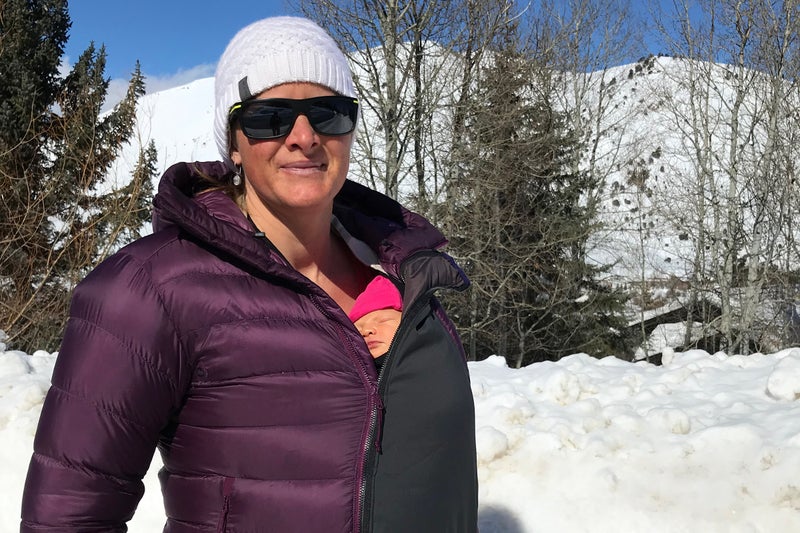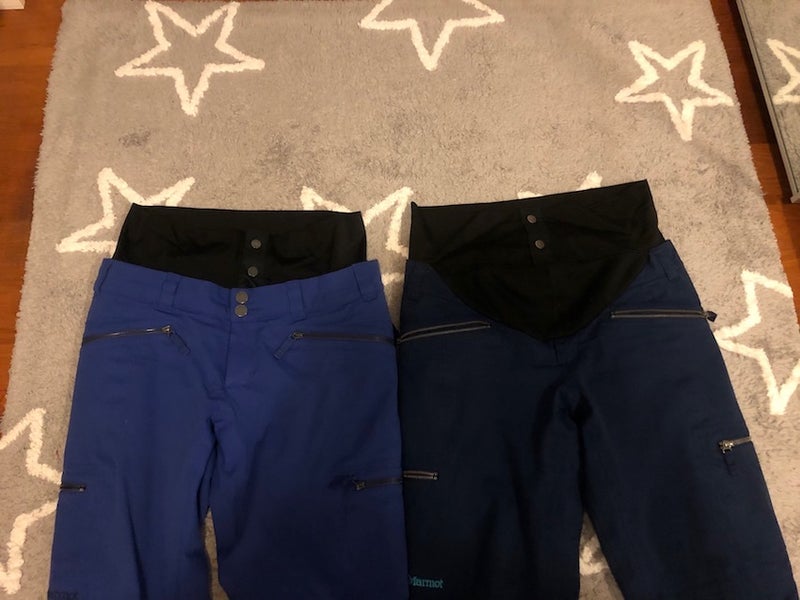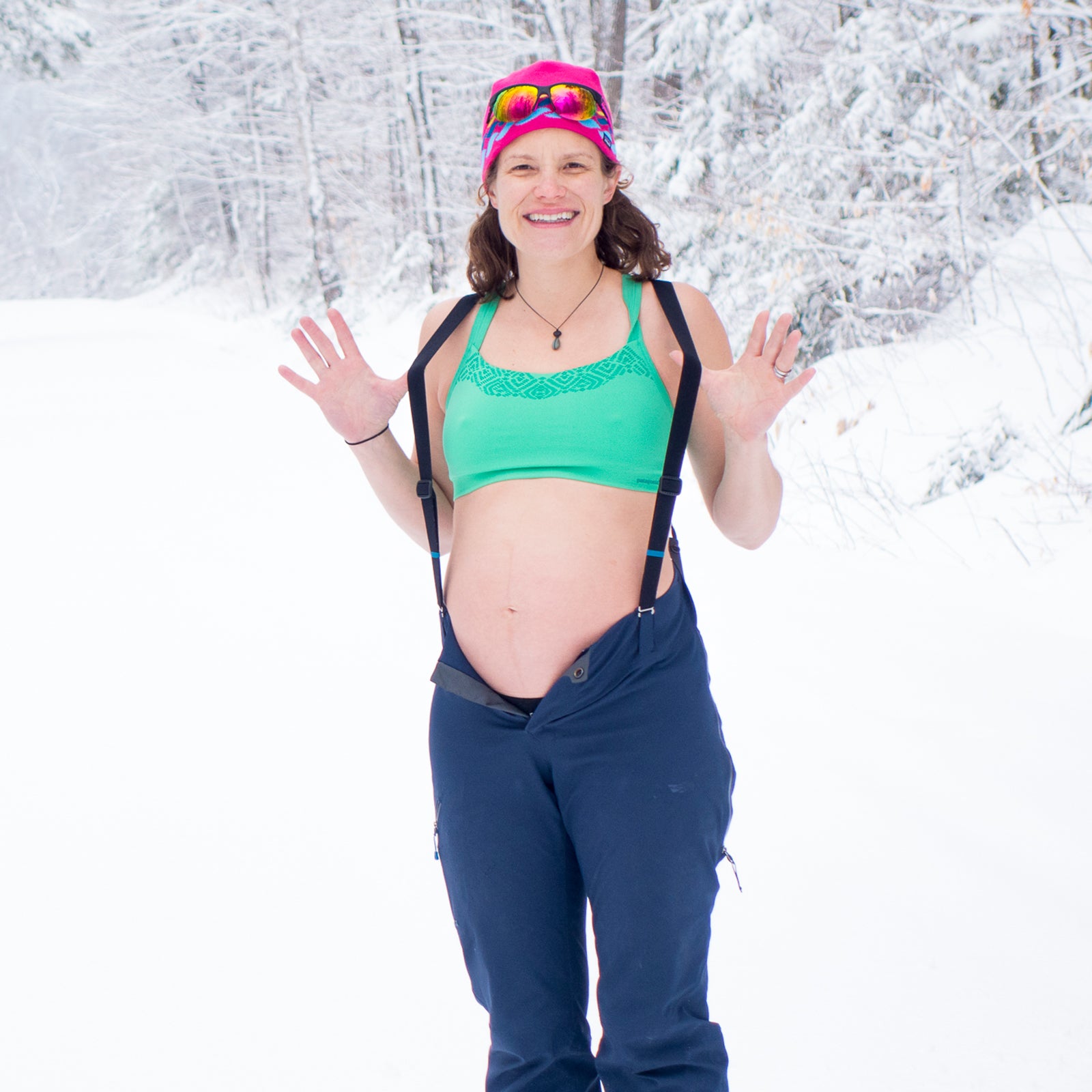In April 2018, traversed the European Alps, the only female ski mountaineer on a four-person team that . Weeks later, back home in Jackson, Wyoming, Smiley learned she was pregnant. Was it time for the professional mountain athlete and coach to sit out a ski season?
Hardly. On November 8, six months pregnant and 25 pounds heavier, Smiley logged her first backcountry ski day with a baby on board. She moved uphill at a slower pace, and it was awkward when her belly bumped her knees midturn. Still, Smiley skied five days a week to keep her body and mind healthy as she prepared for childbirth.
A crucial piece of technical outerwear made her outdoor winter activities more comfortable: a custom jacket extender created for her by a designer at��Arc’teryx.��It was a triangular swath of air-permeable synthetic insulation with two zippers. Each side zipped onto either end��of Smiley’s jackets, adding width to the garments as her body changed. “I can’t wear it without [every woman]��I run into commenting,” she says. “Mostly, ‘Where do I get one? Can I use it when you’re done?’”

But the jacket extender isn’t available in stores, and most major outdoor brands don’t��offer apparel or accessories designed specifically for pregnant women. There’s the�� zipper extender ($63) and�� line of maternity apparel and gear, but outside of these retailers and a couple others, maternity outerwear is scarce.
Meanwhile, maternity-activewear styles, or clothing designed for exercise, have increased 231 percent since 2014 in the U.S., where maternity wear is a $1.96 billion business. Smiley’s experience suggests a growing niche market for maternity technical outerwear.
Motherhood has never stopped women from outdoor sports participation, but��it did once mark��the end of a professional athletic career. That’s changing. At the 2018 Winter Olympics, cross-country skier Kikkan Randall was the only mother on Team USA. But when she won gold in the team sprint, there was another��mother on the podium—bronze medalist Marit Bjorgen of Norway. “We’ve reached a collective consciousness, where more of these stories are being told and seen,” says professional skier��. She has two young daughters and was filmed for the 2016 Warren Miller movie�� while pregnant with her first. “It’s getting to be more the norm.”
That holds true for recreational athletes, too. “We have a lot of very active pregnant women who want to continue to do winter sports,” says Dr. Erin A. S. Clark at University of Utah Health, who has treated pregnant��resort and backcountry skiers, nordic skiers, winter hikers, and snowshoers. “Falls are the primary risk we talk to people about. Otherwise we’re really encouraging.”
Leading experts and government policy echo that. “There’s a mindset that being sedentary makes for a healthier pregnancy, and that’s absolutely wrong,” says Gregory A. L. Davies, who has researched exercise during pregnancy for the International Olympic Committee. The U.S. Department of Health and Human Services recommends 2.5 hours a week of aerobic activity for pregnant women��and states that those accustomed to high-intensity aerobic workouts can safely continue.
“It’s not just empowering women, it’s a good business move,” says Kit DesLauriers. “It says, We hear you, we acknowledge you, and we want to support you in every phase of your life.”
So why don’t many major outdoor brands make anything for pregnant women to wear? Arc’teryx, the North Face, and Patagonia��declined to comment. Interviews with seven brand ambassadors who are mothers indicated that sponsors happily supplied larger sizes during their pregnancies. Recreational athletes rustle up oversize��bibs at the Salvation Army, borrow from partners, and pass on what works to friends. Perhaps because the need for maternity outerwear is short-lived—the nine months a women is pregnant—gear companies rarely get requests. “People are acutely invested [while they’re pregnant], and then they move on,” says Majka Burhardt, a professional climber and mother of twins. Without obvious demand, niche product is a risky investment for manufacturers committed to factory-order minimums.
Then there’s the idea that no one buys pricey new gear for a single season. But that hasn’t stopped the North Face and Patagonia, among others, from producing infant and toddler apparel designed for mere months of use. In fact, two mothers on the North Face’s athlete roster—renowned ski mountaineers and Hilaree Nelson—asked for and collaborated on that brand’s first infant-toddler collection; that��launched in 2010, and��now��the line contains 79 individual styles. DesLauriers thinks a small maternity line could also do well. “It’s not just empowering women, it’s a good business move,” she says. “It says, We hear you, we acknowledge you, and we want to support you in every phase of your life.”
The numbers in the marketplace may deter outdoor companies as well—women do represent a smaller market for technical apparel than men. , which tracks retail data, counted $2.8 billion in outerwear sales last year, and��female garments made up slightly less than half those sales. In the noninsulated-shells category, men’s items outsold women’s $483.6 billion to $247��billion. But as more women stay active well into their pregnancies, the investment for gear companies may be worthwhile.��“Winter clothes were the hardest, and I definitely would have bought a maternity ski pant,” says professional skier Crystal Wright, mother to a one-year-old. “I spend 80 percent of my days in athletic and outdoor wear, so it was tough for me to find clothes that worked or fit.”
“Birth and motherhood are physically draining experiences,” says a professional climber with three-month-old twins. “Embarking on these phases strong, fit, and vibrant from staying active in pregnancy just seems like a way to set yourself up for success.” Caton also owns and operates in British Columbia��and says she’s guided more than 20 pregnant women on snow and rock.

Liz Oakes Smart, an IFMGA-certified guide based in Chamonix, France, skied until she was eight months pregnant with her firstborn. “A certain part of it is I need to work, and this is my job,” she says. “Another part is I’ve skied my whole life, and it’s just what I do.” Now expecting her second child, she plans to guide through her second trimester. Smart also relies on custom gear—two pairs of ski pants she transformed into maternity wear with the help of YouTube tutorials.
Back in Wyoming, Smiley continued to use her jacket extender well into her third trimester, proving that major outdoor brands possess the ability and the capacity to create maternity garments. On February 26, she wore it��on a 1,000-foot ski tour up Snow King, where her contractions began. She later zipped into the jacket extender on the way to St. John’s Medical Center.��Even after her daughter’s arrival, Smiley still finds use for the custom piece.
“I can wear it over a BabyBjörn carrier,” she says. “Now we’ll both go about our winter activities.”


